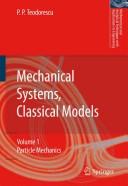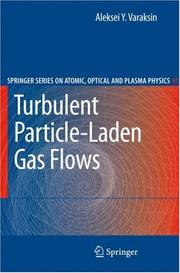| Listing 1 - 10 of 15 | << page >> |
Sort by
|
Book
ISBN: 9781107132849 9781316459300 Year: 2017 Publisher: Cambridge Cambridge University Press
Abstract | Keywords | Export | Availability | Bookmark
 Loading...
Loading...Choose an application
- Reference Manager
- EndNote
- RefWorks (Direct export to RefWorks)
How does a particle accelerator work? The most direct and intuitive answer focuses on the dynamics of single particles as they travel through an accelerator. Particle accelerators are becoming ever more sophisticated and diverse, from the Large Hadron Collider (LHC) at CERN to multi-MW linear accelerators and small medical synchrotrons. This self-contained book presents a pedagogical account of the important field of accelerator physics, which has grown rapidly since its inception in the latter half of the last century. Key topics covered include the physics of particle acceleration, collision and beam dynamics, and the engineering considerations intrinsic to the effective construction and operation of particle accelerators. By drawing direct connections between accelerator technology and the parallel development of computational capability, this book offers an accessible introduction to this exciting field at a level appropriate for advanced undergraduate and graduate students, accelerator scientists, and engineers.
Particle accelerators. --- Particle dynamics. --- Synchrotron radiation.
Book
Year: 1924 Publisher: [Bruxelles : M. Lamertin,
Abstract | Keywords | Export | Availability | Bookmark
 Loading...
Loading...Choose an application
- Reference Manager
- EndNote
- RefWorks (Direct export to RefWorks)
Particle dynamics. --- Orbits --- Gravitation --- Dynamique d'une particule --- Orbites --- Gravitation
Book
ISBN: 9783030886899 Year: 2022 Publisher: Cham Springer International Publishing :Imprint: Springer
Abstract | Keywords | Export | Availability | Bookmark
 Loading...
Loading...Choose an application
- Reference Manager
- EndNote
- RefWorks (Direct export to RefWorks)
Chirality. --- Nanoparticle dynamics. --- Nanoparticles. --- Nano-particles --- NPs (Nanoparticles) --- Nanoscale particles --- Nanostructured materials --- Particles --- Dynamics of nanoparticles --- Nano-particle dynamics --- Nanoparticles --- Particle dynamics --- Stereochemistry --- Symmetry (Physics) --- Enantiomers --- Dynamics
Book
Year: 1923 Publisher: London,New York : Longmans, Green,
Abstract | Keywords | Export | Availability | Bookmark
 Loading...
Loading...Choose an application
- Reference Manager
- EndNote
- RefWorks (Direct export to RefWorks)
Dynamics, Rigid --- Particle dynamics. --- Mechanics --- Dynamique des corps rigides --- Dynamique d'une particule --- Mécanique
Book
Year: 1967 Publisher: San Francisco : Holden-Day,
Abstract | Keywords | Export | Availability | Bookmark
 Loading...
Loading...Choose an application
- Reference Manager
- EndNote
- RefWorks (Direct export to RefWorks)
Particles (Nuclear physics) --- Particle dynamics. --- Quantum theory --- Particules (Physique nucléaire) --- Dynamique d'une particule --- Théorie quantique
Book
ISBN: 067713990X Year: 1972 Volume: v. 11 Publisher: New York, : Gordon and Breach,
Abstract | Keywords | Export | Availability | Bookmark
 Loading...
Loading...Choose an application
- Reference Manager
- EndNote
- RefWorks (Direct export to RefWorks)
Quantum field theory --- Dynamics of a particle --- Théorie quantique des champs --- Dynamique d'une particule --- Biophysics. --- Statistical mechanics. --- Biology --- Mathematical models. --- Théorie quantique des champs --- Particle dynamics.
Book
ISBN: 1421427648 1421429411 Year: 2004 Publisher: Johns Hopkins University Press
Abstract | Keywords | Export | Availability | Bookmark
 Loading...
Loading...Choose an application
- Reference Manager
- EndNote
- RefWorks (Direct export to RefWorks)
As unique sources of coherent high-power, microwave, and millimeter-wave radiation, gyrotrons are an essential part of the hunt for controlled fusion. Presently, gyrotrons are actively used for electron cyclotron resonance plasma heating and current drive in various controlled fusion reactors. These sources have been under development in many countries for more than forty years. In spite of their widespread use, however, there is as yet no single book to introduce non-specialists to this vital field.Now Gregory S. Nusinovich, an early pioneer of the gyrotron and widely regarded today as the world's leading authority on the subject, explains the fundamental physical principles upon which gyrotrons and related devices operate. Nusinovich first sets forth some "rules of thumb" that allow readers to understand gyrotron operation in simple terms. He then explores the fundamentals of the general theory of gyrotrons and offers an overview of the various types of gyro-devices, including gyromonotrons, gyroklystrons, gyro-traveling-wave tubes, and gyrotwystrons. He explains not only the theory, linear and nonlinear, but also the practical challenges that users of such devices face. This book will be of interest to undergraduate and graduate students as well as to those who develop gyrotrons or who use them in various applications. It should also appeal to plasma physicists interested in charged-particle dynamics, as well as to applied physicists needing to know more about micro- and millimeter-wave technologies.
Dynamics of a particle. --- Plasma radiation. --- Gyrotrons. --- Particle dynamics. --- Cyclotron resonance masers --- Microwave tubes --- Bremsstrahlung --- Cyclotron resonance --- High temperature plasmas --- Radiation --- Dynamics of a particle --- Dynamics of particles --- Particles --- Dynamics --- Wave mechanics (vibration & acoustics)

ISBN: 1280937815 9786610937813 1402054424 1402054416 9048173698 Year: 2007 Publisher: Dordrecht : Springer,
Abstract | Keywords | Export | Availability | Bookmark
 Loading...
Loading...Choose an application
- Reference Manager
- EndNote
- RefWorks (Direct export to RefWorks)
All phenomena in nature are characterized by motion; this is an essential property of matter, having infinitely many aspects. Motion can be mechanical, physical, chemical or biological, leading to various sciences of nature, mechanics being one of them. Mechanics deals with the objective laws of mechanical motion of bodies, the simplest form of motion. In the study of a science of nature mathematics plays an important role. Mechanics is the first science of nature which was expressed in terms of mathematics by considering various mathematical models, associated to phenomena of the surrounding nature. Thus, its development was influenced by the use of a strong mathematical tool; on the other hand, we must observe that mechanics also influenced the introduction and the development of many mathematical notions. In this respect, the guideline of the present book is precisely the mathematical model of mechanics. A special accent is put on the solving methodology as well as on the mathematical tools used; vectors, tensors and notions of field theory. Continuous and discontinuous phenomena, various mechanical magnitudes are presented in a unitary form by means of the theory of distributions. Some appendices give the book an autonomy with respect to other works, special previous mathematical knowledge being not necessary. Some applications connected to important phenomena of nature are presented, and this also gives one the possibility to solve problems of interest from the technical, engineering point of view. In this form, the book becomes – we dare say – a unique outline of the literature in the field; the author wishes to present the most important aspects connected with the study of mechanical systems, mechanics being regarded as a science of nature, as well as its links to other sciences of nature. Implications in technical sciences are not neglected. Audience: Librarians, and researchers interested in the fundamentals of mechanics.
Dynamics of a particle --- Mechanics --- Mathematical models. --- Classical mechanics --- Newtonian mechanics --- Physics --- Dynamics --- Quantum theory --- Particle, Dynamics of a --- Mechanics. --- Mathematics. --- Mathematical physics. --- Classical Mechanics. --- Applications of Mathematics. --- Mathematical Methods in Physics. --- Physical mathematics --- Math --- Science --- Mathematics --- Applied mathematics. --- Engineering mathematics. --- Physics. --- Natural philosophy --- Philosophy, Natural --- Physical sciences --- Engineering --- Engineering analysis --- Mathematical analysis

ISBN: 1280951494 9786610951499 3540680543 3540680535 3642087728 Year: 2007 Publisher: Berlin ; New York : Springer,
Abstract | Keywords | Export | Availability | Bookmark
 Loading...
Loading...Choose an application
- Reference Manager
- EndNote
- RefWorks (Direct export to RefWorks)
Results are given of experimental and theoretical studies of "gas-solid particles" turbulent two-phase flows. Special emphasis is placed on studies of the behavior of particles suspended in a turbulent gas flow and their feedback effect on the characteristics of flow of the carrier phase. The characteristics of heterogeneous flows in channels (pipes) are analyzed, as well as those in the vicinity of the critical points of bodies subjected to flow and in the boundary layer developing on their surface. Problems of physical simulation of turbulent gas flows which carry solid particles are treated in detail. This monograph will be useful for researchers involved in investigations of gas dynamics and heat and mass transfer in multiphase flows, as well as for university professors, post-graduate students, and students.
Gas flow. --- Two-phase flow. --- Dynamics of a particle. --- Particle, Dynamics of a --- Flow, Two-phase --- Fluid dynamics --- Multiphase flow --- Flow of gas --- Gases, Flow of --- Aerodynamics --- Gas dynamics --- Air flow --- Engineering. --- Fluid- and Aerodynamics. --- Engineering, general. --- Construction --- Industrial arts --- Technology --- Fluids. --- Hydraulics --- Mechanics --- Physics --- Hydrostatics --- Permeability
Book
ISBN: 9400736835 9048127637 9786612459894 1282459899 9048127645 Year: 2009 Publisher: New York ; Dordrecht : Springer Science + Business Media,
Abstract | Keywords | Export | Availability | Bookmark
 Loading...
Loading...Choose an application
- Reference Manager
- EndNote
- RefWorks (Direct export to RefWorks)
This third volume completes the Work Mechanical Systems, Classical Models. The first two volumes dealt with particle dynamics and with discrete and continuous mechanical systems. The present volume studies analytical mechanics. Topics like Lagrangian and Hamiltonian mechanics, the Hamilton-Jacobi method, and a study of systems with separate variables are thoroughly discussed. Also included are variational principles and canonical transformations, integral invariants and exterior differential calculus, and particular attention is given to non-holonomic mechanical systems. The author explains in detail all important aspects of the science of mechanics, regarded as a natural science, and shows how they are useful in understanding important natural phenomena and solving problems of interest in applied and engineering sciences. Professor Teodorescu has spent more than fifty years as a Professor of Mechanics at the University of Bucharest and this book relies on the extensive literature on the subject as well as the author's original contributions. Audience: scientists and researchers in applied mathematics, physics and engineering.
Dynamics of a particle -- Mathematical models. --- Mechanics -- Mathematical models. --- Applied Mathematics --- Applied Physics --- Engineering & Applied Sciences --- Mechanics --- Dynamics of a particle --- Mathematical models. --- Particle, Dynamics of a --- Classical mechanics --- Newtonian mechanics --- Physics. --- Applied mathematics. --- Engineering mathematics. --- Mechanics. --- Mathematical Methods in Physics. --- Applications of Mathematics. --- Physics --- Dynamics --- Quantum theory --- Mathematical physics. --- Mathematics. --- Classical Mechanics. --- Math --- Science --- Physical mathematics --- Mathematics --- Engineering --- Engineering analysis --- Mathematical analysis --- Natural philosophy --- Philosophy, Natural --- Physical sciences
| Listing 1 - 10 of 15 | << page >> |
Sort by
|

 Search
Search Feedback
Feedback About UniCat
About UniCat  Help
Help News
News